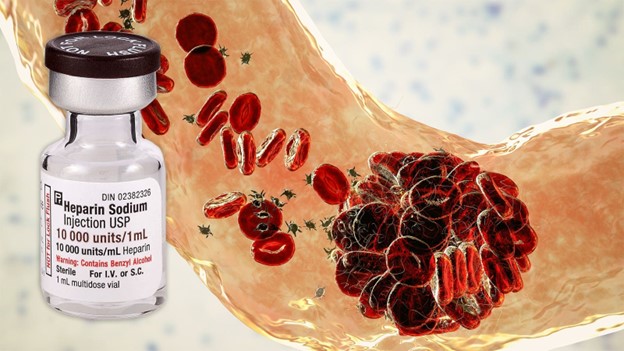A nurse is reinforcing teaching with a client who is to start subcutaneous heparin.
Which of the following information should the nurse include in the teaching?
Use a soft-bristled toothbrush.
Inject the medication deep into the thigh muscle.
Expect stools to become black and tarry.
Easy bruising indicates the medication is effective.
The Correct Answer is A
The nurse should include in the teaching that the client should use a soft-bristled toothbrush.
Heparin is an anticoagulant that decreases the clotting ability of the blood 1.
Using a soft-bristled toothbrush can help prevent bleeding of the gums while brushing teeth.

Choice B is incorrect because heparin should not be injected deep into the thigh muscle.
Instead, it should be given subcutaneously (under the skin) 2.
Choice C is incorrect because black and tarry stools are not an expected side effect of heparin.
Choice D is incorrect because easy bruising does not indicate that the medication is effective.
Instead, easy bruising may be a side effect of heparin and should be reported to the healthcare provider 1.
Nursing Test Bank
Naxlex Comprehensive Predictor Exams
Related Questions
Correct Answer is B
Explanation
“I understand your request to have only male staff members attend to your care.” This response acknowledges the client’s request and shows that the nurse is willing to listen to his concerns.
Choice A is not the correct answer because it can be perceived as confrontational and may make the client feel uncomfortable.
Choice C is not the correct answer because it dismisses the client’s request and may make him feel unheard.
Choice D is not the correct answer because it implies that the nurse will immediately comply with the client’s request without further discussion or consideration of other options.
Correct Answer is D
Explanation
Heparin is an anticoagulant that is used to decrease the clotting ability of the blood and help prevent harmful clots from forming in blood vessels 1.
However, heparin will not dissolve blood clots that have already formed, but it may prevent the clots from becoming larger and causing more serious problems 12.

Choices A, B, and C are incorrect because heparin does not dissolve existing clots. Instead, it works to prevent new clots from forming 12.
Whether you are a student looking to ace your exams or a practicing nurse seeking to enhance your expertise , our nursing education contents will empower you with the confidence and competence to make a difference in the lives of patients and become a respected leader in the healthcare field.
Visit Naxlex, invest in your future and unlock endless possibilities with our unparalleled nursing education contents today
Report Wrong Answer on the Current Question
Do you disagree with the answer? If yes, what is your expected answer? Explain.
Kindly be descriptive with the issue you are facing.
